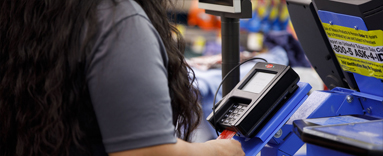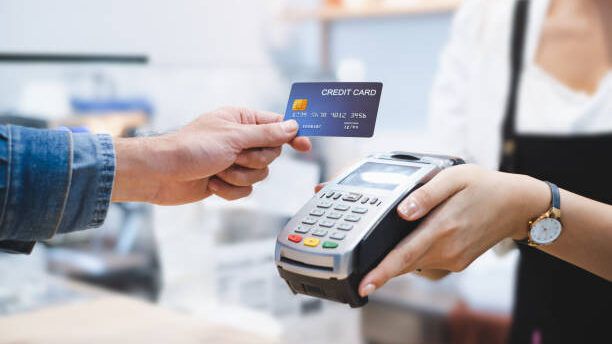A technology that’s been used for years overseas is finally becoming more common here in the U.S.: contactless credit cards. The rollout of this technology couldn’t come at a better time, since we are all looking for ways to reduce the amount of contact we have with public surfaces during the COVID-19 pandemic.
However, you may be wondering how these cards work, if the technology is secure and which banks issue contactless cards. So, let’s dive into everything you need to know about contactless credit cards.
How Contactless Cards Work
Contactless credit cards have a small embedded chip that emits short-range radio waves. When you place your card within a few inches of a contactless-enabled payment terminal, your payment information is transferred.
While it’s often referred to as “tap to pay,” no tapping is actually needed. Instead, you usually need to place your card within a few inches of the payment terminal to initiate payment.
It may take a second or two for the transaction to complete, so don’t pull your card away too quickly. To indicate when the transaction is complete, the payment terminal may beep, display a green checkmark or flash a green light.

In order to use the contactless payment feature, the merchant will need to have a contactless-enabled terminal. These payment terminals are quickly becoming ubiquitous in the U.S., as they already are in Canada, Europe and Australia. You can use tools like this to find merchants near you that accept MasterCard contactless cards.
If you have multiple contactless credit cards, you won’t want to tap your wallet or purse on a card terminal. Otherwise, the transaction might post to a card other than the one you intended.
Contactless Payment Security
After learning about how they work, perhaps contactless credit cards seem a little too easy to be safe. Thankfully, you don’t have to worry about the security of the technology.
One-Time Code
Like the chips in our credit cards, the contactless card chip creates a one-time code for each individual transaction to accompany your payment information. This code is transmitted with your account number when you “tap” to pay. Your name, billing address and card verification code aren’t transmitted.
Even if someone were able to fraudulently obtain your payment information, it would be nearly impossible for them to complete a contactless payment. In order to generate the one-time code, the thief would need to crack the complex algorithm that the bank uses to generate this.
This one-time code makes contactless credit cards safer to use than the magnetic stripe. When you swipe a magnetic stripe, your payment and personal information can be captured by a skimming device. Hackers can then use that information to create a duplicate magnetic stripe for fraudulent transactions.
Physical Security
Instead, the biggest security issue with contactless credit cards involves physical possession of the card. No PIN or signature is typically required when using contactless payment. So, if your card is lost or stolen, it could be used by someone else without easy detection.
However, this isn’t a reason to leave your contactless cards at home. If your card is stolen, the credit card company’s fraud protection should cover any fraudulent charges.
For this reason, some card issuers have a limit on the amount that can be paid via contactless payment. For example, American Express typically has a limit of $30 or €30 per transaction. However, many of these limits are being raised or eliminated due to COVID-19.

Benefits of Contactless Credit Cards
In addition to the security benefits, there are a lot of other reasons to get and use a contactless credit card.
Speed
By now, we all are familiar with the speed—or lack thereof—of paying by “dipping” a credit card chip. It takes long enough between inserting the card and getting a confirmation that most payment terminals will buzz or ding to alert you when you can finally remove your card.
In comparison, “tapping” to pay using a contactless chip can take just seconds. So, contactless payments are much faster than dipping a credit card or paying with cash. Meanwhile, it’s safer and not much slower than swiping a credit card.
Reduced Contact with Public Surfaces
Since the beginning of the COVID-19 pandemic, we are all a lot more conscious of the public surfaces we touch. Using contactless credit cards helps avoid more touch points as we go through the day.
Less Wear-and-Tear
Magnetic strips and EMV chips can wear out from repeated contact with payment terminals. Contactless chips—by their very nature—won’t suffer this problem.
A contactless card chip should last for years. However, occasionally an issue could prevent it from continuing to work. If your card stops working, you should easily be able to contact your card issuer to get a replacement.
Better for Overseas Travel
While many of us aren’t able to travel overseas now, another benefit of contactless cards will be obvious once international travel resumes. Chip and PIN technology has become so ubiquitous overseas—particularly in Europe and Australia—that the technology is assumed.
Many self-serve ticket machines require either a Chip and PIN-enabled card or contactless payment. If you don’t have a card with Chip and PIN technology, using a contactless credit card may be the only way you can pay.
Banks That Issue Contactless Credit Cards
Although you may just be learning about it, contactless credit cards are quickly becoming the norm in the U.S. There are currently over 190 million contactless Visa credit cards in circulation, and Visa expects that number to hit 300 million by the end of the year. Currently, most major American credit card issuers are sending out contactless cards by default.
American Express
American Express says that “most American Express products have contactless technology” and recommends that cardmembers “look for the contactless symbol on the back or front of your Card.” If you don’t already have a contactless card, your next renewal card or replacement card will have this feature. However, not all Amex products will be installed with a contactless chip.
Bank of America
Bank of America began issuing contactless credit cards in mid-2019, but only to cardholders in New York City, Boston and San Francisco. Now, all newly-issued Bank of America credit cards are contactless-enabled. Contactless Bank of America debit cards will be available by request starting in “late 2020.”
Capital One
Many U.S.-issued Capital One credit cards come with contactless card chips. This includes popular cards like the Capital One® Venture® Rewards Credit Card*, Capital One® Savor® Cash Rewards Credit Card*, Capital One® SavorOne® Cash Rewards credit card*, Capital One® Quicksilver® Cash Rewards Credit Card* and Capital One® QuicksilverOne® Cash Rewards Credit Card*.
Chase
Chase’s portfolio currently includes 22 credit cards that are issued with contactless chips. That includes some of our favorite credit cards, such as the Chase Sapphire Reserve®, Chase Sapphire Preferred® Card, Chase Freedom Unlimited® and the Ink Business Preferred®.
Citi
Citi doesn’t list which credit cards have contactless chips, only noting that the feature is “included with Select Citi® Cards.” However, Citi lists whether a card is contactless or not on the card detail page.
For example, the Citi Prestige® Card*, Citi Premier℠ Card*, Citi® Double Cash Card, Citi Rewards+℠ Card, Citi® / AAdvantage® Platinum Select® World Elite™ Mastercard®* and CitiBusiness® / AAdvantage® Platinum Select® Mastercard®* are all currently being issued as contactless cards.
Bottom Line
Even before the COVID-19 pandemic, contactless credit cards were poised to take root in the U.S. The payment method is faster than dipping a credit card chip and more secure than swiping a credit card stripe. But, it might be the “contactless” aspect that ultimately sells us on adopting the payment method.
Now that you know how contactless credit cards work, take a closer look at your cards to see which are contactless. Now would be a great time to contact your bank to request a contactless card, if you don’t already have one.
This article was originally published By JT Genter, forbes.com.












